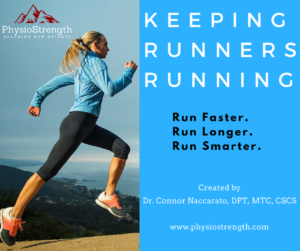How to Run a 5k Personal Record in 8 Weeks

Guest Blog Post: Justin Thompson, PT, CMPT
This blog post is a special guest post from a colleague of mine, Justin Thompson, PT, CMPT. He is a physical therapist and running coach in Gainesville, Florida and owner of Thompson Physical Therapy. He has created a free PDF document for runners with some helpful programming tips for the 5k race. The following information is directly from his PDF and is meant to provide runners with some useful and actionable information that you can implement today in preparation for your next 5k! Enjoy!
For many, the 5k distance can be deceptively hard. It is the one of the shortest of the line-up of road races and is considered an “entry level” distance according to some. However, to run the distance well requires proper training and skill. You may be thinking, “What skill? I am just running.” Believe it or not, running, as simple as it may look, is quite complex when you break it down.
My goal for this document isn’t to break down running completely, but to show you some of the “skill” that is required to run a personal best in a 5k. I will give you some cues, some thought processes, and some drills that you can perform that will help with your performance on race day. I hope that this document proves helpful in getting you to achieve your goal of achieving a personal best in a 5k. Remember that this advice is just that…advice! It is not a replacement for a proper assessment and personalization of your specific needs. With that said, I believe that the information found here can help the majority of runners at both the competitive or recreational level.
1. Build Aerobic Capacity
The majority of your weekly time running should be spent working on your aerobic engine. I want you to think diesel engine rather than drag racer. Think about it this way a diesel engine is known for its fuel economy, but not necessarily for its speed. “But it is only a 5k! I need more speed than endurance!” Maybe, but it is very difficult to build speed onto a poor base of endurance…speed that lasts anyway. Think also about the fact that most elite runners run at a ratio of 80/20. That is 80% at aerobic (low) intensity and 20% at moderate to high intensity. Check out this article from Runner’s World. If it is good enough for the elites, then it has to be good enough for you and me!
Action plan: More mileage at aerobic (conversational) pace
2. Concentrate on Balance
Try this right now; stand on one foot for 30 seconds. Now try to stand on one foot with your eyes closed. Could you do it? Many people I work with can’t even stand on one foot with their eyes open, much less closed. The truth is we are very visual. We rely heavily on our vision to hold us upright and keep our balance in check. Because of this, we haven’t developed the proprioceptive feedback from our feet and legs to our brain. Proprioception is the ability to feel how our body is oriented in space. If we can feel ourselves losing our balance, then we can make the small changes to correct it. We also have not developed the stabilizing muscles in the feet and legs. If these muscles are activating during our running, it gives us greater stability and power pushing us forward. This is what you want right? To go forward faster?
Action plan: Single leg balance drills
3. Improve Mobility
In order to run without significant compensations, wasted energy, and risk for injury there are certain areas in our body that require increased mobility. Two of these areas are the ankles and the hips. Measuring ankle mobility, you should be able to sit in a chair with your foot flat on the floor, scoot your butt forward in the chair until your knee goes just slightly past your toes. This should be fairly effortless. If you are feeling tension in your calf, your heel lift off the ground, or a pinch in the front of your ankle, then you have an ankle mobility issue. This should be cleaned up to ensure proper loading through the ankles. For the hips, you really need to have good hip extension to make sure that you are able to properly activate your glute and propel you forward. You should be able to kneel on one knee with the other knee up in front of you, engage your abdominals to tuck your butt underneath you to flatten your low back. If you feel tension in your front of your hip or thigh, then you really need to work on your hip extension mobility.
Action plan: Calf stretching, ankle mobilization, hip flexor stretch
4. Create Stability
Stability is key for transferring force. Try lifting 100 lbs while standing on an inner tube in the middle of a lake. Now try lifting 100 lbs on dry land. Which is easier? Now I know you have either walked or run on sand before. Remember that time at the beach when a 1 mile walk felt like a marathon? Why? Stability! It just makes sense, stability allows you to generate more force without wasting energy. If your midfoot, lateral hips, and lumbar spine are not stable, then you are just losing the ability to transmit force from the ground through your body to propel you forward.
Action plan: Arch lifts, resisted hip abduction, planks
5. Leverage Elasticity
The human body has elasticity built within it. What happens when you stretch a rubber band? It naturally wants to pull back to its original length. Your tendons respond to quick stretch in much the same way as a rubber band. The emphasis here is on “quick.” They will store that energy in the tendon and quickly return it to generate force. You have to be able to train your body to optimize this free energy return, so that you can generate more force with less effort. This is trained through plyometrics. We have to train the body to have a short ground contact time. If you can tap into this free energy, then just imagine how much longer you could go at a given pace.
Action plan: Box jumps, skipping rope
6. Generate Power
We humans have a muscle group that is optimized for propelling us up and forward. This muscle group is called the glutes. Specifically, your gluteus maximus is one of the largest muscles in the body, and its orientation at the back side of our hips makes it the prime power muscle in running. The problem with this muscle is that we as a culture spend a lot of time sitting, which reduces blood flow to the muscle and makes it less able to create force. We also have stopped learning how to activate it properly. Powerful glutes are what is going to help you generate the speed required to propel you to a new PR. Training the glutes with bridges, hip thrusts, and deadlifts need to be a part of your regular programming if you want to reach your potential.
Action plan: Bridges with band around knees, deadlift, walking lunges progressed to jump lunges
Conclusion
If you start to implement these 6 strategies for the next 8 weeks, you are almost guaranteed to improve your 5k time. So how can you implement all of this in reality? It is really hard to do it all without guidance. Instead of overwhelming yourself with all 6, I recommend you pick the top 3 that pertain to you and start there. Once you develop a good routine with those three exercises, feel free to add some of the other ones in as appropriate.
Aerobic capacity: Add 10% per week of mileage or time (all at conversational pace)
Balance: 2x 30 seconds single leg stand on each leg as part of your warm-up (2 minutes total)
Mobility: 8 minutes of stretching 4-5 days a week (2 minutes each calf, 2 minutes each hip flexor)
Stability: 3 days a week do the following: 20 arch lifts while standing, hip abduction while lying on your side 15 times, front and side planks for 30 seconds each
Elasticity: 5 sets of 6 reps box jumps 2 days a week
Power: Walking lunges for 2 sets of 12, 2-3 days a week. When appropriate, progress to jump lunges.
It’s time to start putting this into practice and see the improvements start to roll in within 4-6 weeks. The key is to stay consistent all the way up until 5k race day. Of course, if you need further instruction, please don’t hesitate to reach out to your local physical therapist for further evaluation, coaching, and programming.
Take your running training to the next level with our online running workshop: Keeping Runners Running
If you are a runner in the Gainesville Florida region, you can reach out to Justin Thompson directly at justin@thompsonphysicaltherapy.com or check out his website at www.thompsonphysicaltherapy.com. If you want to download this post as a free PDF to share with friends/family, click here.
I am also well versed in working with runners and am always happy to answer running related questions. Feel free to contact me directly at cnaccarato@physiostrength.com. If you would like to schedule your appointment at PhysioStrength Physical Therapy, you may do so here.
Please feel free to share this with other runners who you think might find value in it.
Sincerely, Dr. Connor Naccarato DPT, MTC, CSCS


